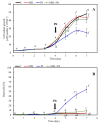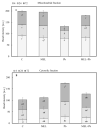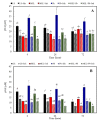Melatonin Protects Tobacco Suspension Cells against Pb-Induced Mitochondrial Dysfunction
- PMID: 34948164
- PMCID: PMC8703733
- DOI: 10.3390/ijms222413368
Melatonin Protects Tobacco Suspension Cells against Pb-Induced Mitochondrial Dysfunction
Abstract
Recent studies have shown that melatonin is an important molecule in plant physiology. It seems that the most important is that melatonin effectively eliminates oxidative stress (direct and indirect antioxidant) and switches on different defence strategies (preventive and interventive actions) during environmental stresses. In the presented report, exogenous melatonin potential to protect Nicotiana tabacum L. line Bright Yellow 2 (BY-2) exposed to lead against death was examined. Analyses of cell proliferation and viability, the level of intracellular calcium, changes in mitochondrial membrane potential (ΔΨm) as well as possible translocation of cytochrome c from mitochondria to cytosol and subsequent caspase-like proteolytic activity were conducted. Our results indicate that pretreatment BY-2 with melatonin protected tobacco cells against mitochondrial dysfunction and caspase-like activation caused by lead. The findings suggest the possible role of this indoleamine in the molecular mechanism of mitochondria, safeguarding against potential collapse and cytochrome c release. Thus, it seems that applied melatonin acted as an effective factor, promoting survival and increasing plant tolerance to lead.
Keywords: BY-2 tobacco cells; caspase-like protease; cytochrome c; melatonin; mitochondria; programmed cell death.
Conflict of interest statement
The authors declare no conflict of interest. The funders had no role in the design of the study; in the collection, analyses, or interpretation of data; in the writing of the manuscript; or in the decision to publish the results.
Figures






References
-
- Nicholls A.M., Mal T.K. Effects of lead and copper exposure on growth of an invasive weed, Lythrum salicaria L. (Purple Loosestrife) Ohio J. Sci. 2003;103:129–133.
-
- Kabata-Pendias A. Trace Elements in Soils and Plants. 4th ed. CRC press; Boca Raton, FL, USA: 2010.
MeSH terms
Substances
LinkOut - more resources
Full Text Sources

